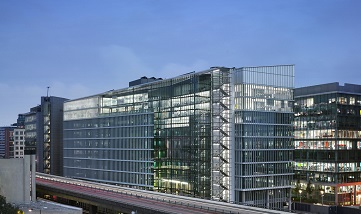 |
| AstraZeneca's headquarters in London--Courtesy of AstraZeneca |
AstraZeneca is cutting an additional 550 jobs from its ranks, bringing the total to 5,600 in an expanded restructuring designed, in part, to give it more money for deals.
The pharma giant included the news of the additional job cuts, which will be made by the end of 2016, as generic competition continued to eat into its bottom line in 2013. AstraZeneca ($AZN) also suffered a major blow with a $1.76 billion impairment charge tied to the underperformance of Bydureon. And AstraZeneca increased the cost of the restructuring program by $200 million, bringing the total to $2.5 billion.
There's no word yet on which units will be cut deepest in the expanded restructuring, though R&D has suffered some of the deepest cuts so far.
"These restructuring initiatives have been expanded in order to create further headroom to invest behind the pipeline and key growth platforms," AstraZeneca noted in its release today. "Additional activities include a transformation of the IT organization and infrastructure, the exit of R&D activities in Bangalore, India, and the exit from branded generics in certain emerging markets to further reduce costs and increase flexibility."
AstraZeneca said a few days ago that it had decided to shutter its facility in Bangalore, where investigators had been working on new therapies for neglected tropical diseases, TB and malaria. Several pharma giants have been adding to their R&D activities for neglected diseases, stung by criticism that they have traditionally been focused more on new drugs for affluent countries. But evidently that's a luxury AstraZeneca can't afford any longer. Several projects are being transferred to other sites in the shut-down.
AstraZeneca has been on a deal spree since even before Pascal Soriot took over as CEO. Over the past year the pharma giant says it more than doubled the number of drugs it had in Phase III or under regulatory review, boosting the total to 11. And AstraZeneca says it has its eye on 19 other programs that could go into Phase III either later this year or in 2015.
Among AstraZeneca's top new prospects are MEDI4736, an anti-PD-L1 monoclonal antibody, part of the hot immunotherapy field, and AZD9291, a third generation irreversible epidermal growth factor receptor TKI. Both are expected to launch into Phase III in 2014. ISI's Mark Schoenebaum also noted that the company is moving its BACE inhibitor for Alzheimer's into Phase III, putting the company right behind Merck in a closely-watched program for the memory-wasting disease.
"We have a very potent molecule (AZD3293), not dissimilar to Merck's molecule," noted AstraZeneca's Mene Pangalos, according to a report in Reuters. He added that there were no signs of the toxicity issues that had scuttled Eli Lilly's BACE inhibitor.
Investigators keep coming back to BACE because it's been repeatedly highlighted as a very promising approach to interrupting the disease pathology, targeting a toxic protein believed to play a big role in the disease. That point was underscored just recently by Yong Shen, an investigator at the Roskamp Institute, who concluded that "there is more and more evidence that BACE1 is intricately involved in the development of AD." But there are unanswered questions about the beta secretase approach and its potential impact on myelination. Also, Roche also recently dumped its early-stage BACE program, without explaining the reason for the move.
- here's the press release (PDF)
- here's the Reuters story on AZD3293